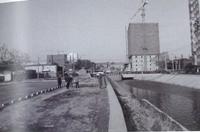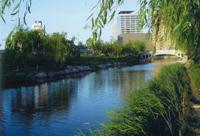|
Before restoration
|
|
After Restoration
|
Zhuanhe River flowing through Beijing was once an important river preventing flooding and supplying water to the outer moat around Beijing Castle. However, during the 1975-to-1982 period, land was reclaimed from the river along with urbanization and many factories and houses were constructed in the reclaimed area. Along with the growing importance of the waterfront environment in the city, however, the City of Beijing started a project to restore Zhuanhe River to its original state in May 2002.
One of the big features of this project is Beijing’s unprecedented awareness of river conservancy, and the project was conducted under the principle of “human-oriented river development to seek harmony and coexistence with nature.” On the premise that river functions are achieved to connect local history and city life organically, this project provides six landscape areas comprising a historical cultural area, ecological park, stone-arranged water scene, waterfront corridor, water garden, and green water channel, without damaging the ecosystem.
By JRRN-secre | Category: Restoration Project,China | Comment(0) | Trackback(0) |
Date: 2009.01.05 16:06
Along the midstream and downstream of Yangtze River, the number of lakes connected to the river drastically decreased from a hundred to three. As a result, the lakes’ ecology was badly destroyed, and their flood prevention and water storage abilities were quite damaged. In 1998, Yangtze River experienced the secondly largest flood after 1954. As post-disaster measures, total measures including constructing hydraulic systems, preventing epidemic, rebuilding housing areas, restoring ecosystem, and appealing for international cooperation, are decided as the nation and are now in operation. Nature restoration has been underway, focusing on wetlands.
>>More details (PDF 33KB)
By JRRN-secre | Category: Restoration Project,China | Comment(0) | Trackback(0) |
Date: 2008.03.31 19:45
Shanghai is a big city with the population of 16 million (including 3 million guest laborers). Forests of tall buildings are observed along the opposite bank of PuDong’s economic deregulation area.
Shanghai, estimated by the World Bank, will grow into a city of 25-million population by 2010. It is among the big cities developing at the “Arian speed” and the “Chinese scale.” Therefore the problems that accompany urbanization is quite noticeable.
>>More details (PDF 40KB)
By JRRN-secre | Category: Restoration Project,China | Comment(0) | Trackback(0) |
Date: 2008.03.31 19:18







